Are We Headed Towards a Demographic Collapse?
The rapid decline in birth rates globally deserves our attention. Let’s explore how the numbers stack up.
Are We Headed Towards a Demographic Collapse?
The rapid decline in birth rates globally deserves our attention. Let’s explore how the numbers stack up.
As we move through the 21st century, numerous countries, particularly in the developed world, are experiencing significant declines in birth rates, which threaten to restructure societies in profound and potentially detrimental ways. This phenomenon is particularly pronounced in the United States, where birth rates have seen a sharp drop, a reduction of 6.8% per year in 2022 compared to 2016. Such a demographic shift poses a serious challenge, potentially shaking the foundational structures that underpin nations.
This precipitous decline in birth rates, paired with the simultaneous extension of life expectancy, is resulting in a major shift in the demographic makeup of many societies, with a tilt towards older populations. Economically, this presents a considerable problem: as the proportion of older people increases, so too does the dependency ratio, the ratio of non-working to working age individuals. This imbalance creates immense pressure on younger generations who must shoulder the burden of supporting a larger, older, and non-working population. The social security and healthcare systems are expected to face enormous strains, potentially leading to their insolvency. Additionally, with fewer young people entering the workforce, innovation and economic productivity may stagnate or decline, threatening national and global economic stability.
At the 2023 PopStats Research Conference, Brian Stickland and Dustin Stancil explored the implications of falling birth rates in the US. Their research illuminated a topic that often goes unnoticed despite its pressing significance. The key findings of their presentation are highlighted below.
Fertility Globally
Fertility rates are declining globally. Since 1950, we’ve seen a 50% reduction in the average number of children per woman. Two of the leading factors in this decline are better and more widely adopted contraception methods, and increasing levels of education. This is most evident in countries like Angola, where a female with no education averages 7.8 children and one with a college education averages 2.3.
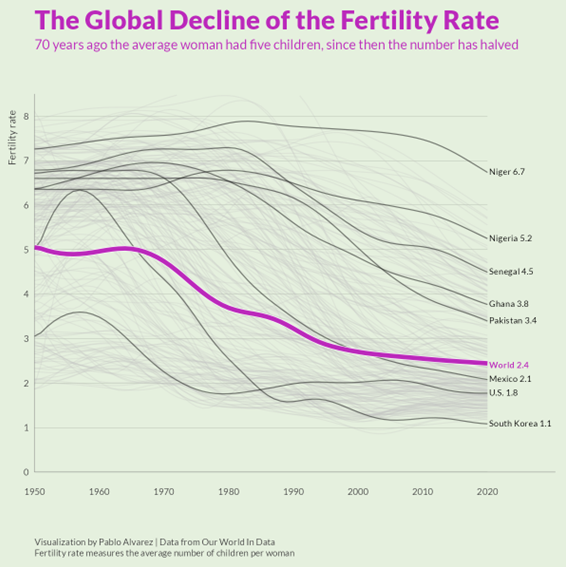
In developed economies, we can clearly observe how higher life expectancies aren’t the only thing leading to a top heavy age graph. In Italy, birth rates have been declining steadily for the past 70 years. In 1950, the average Italian woman had 5.3 children, but by 2022, that number had fallen to 1.24 children per woman.
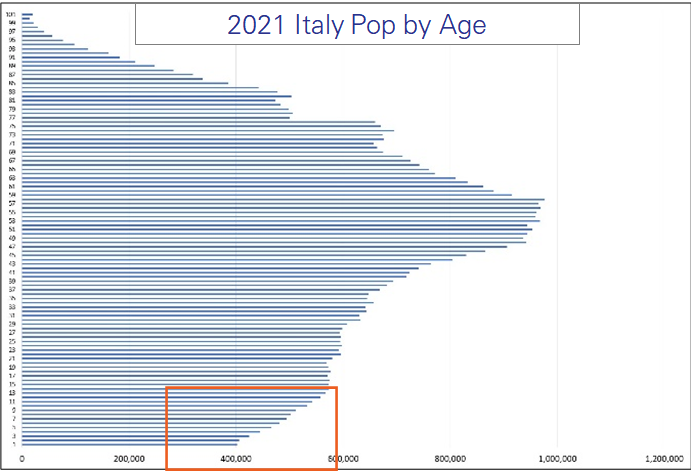
In the US, currently the 0-4 age range is the smallest cohort under 65.
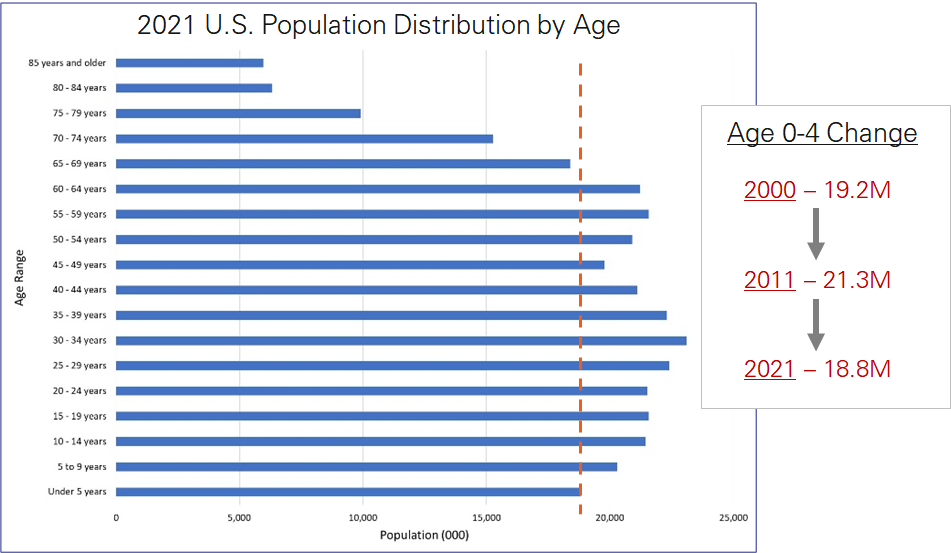
Generational viewpoint
As we look at the shifting socio-cultural landscape, another way of tracking population growth is to look at it generationally. Brian and Dustin looked at population and the following blocks to see how they compare to one another.
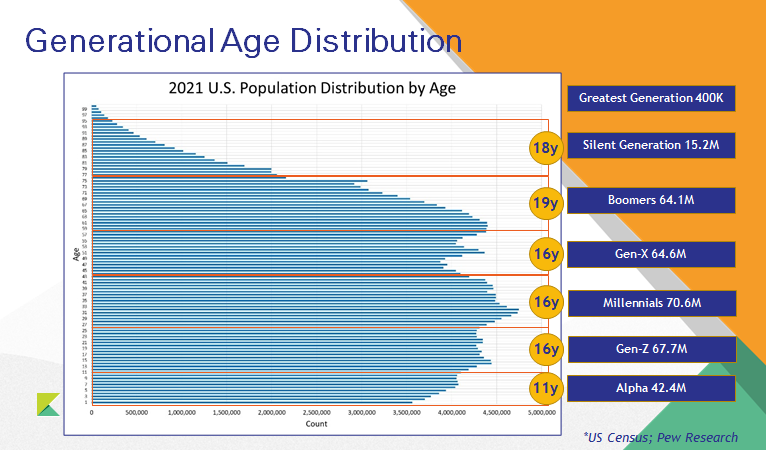
Now a little math to project the eventual size of generation “Alpha”, as they called it, and we observe that even in a best case scenario, we’re confronted with a 7.8M gap compared to the previous generation. In conversation the presenters and attendees discussed how numerous social and cultural factors contribute to the global decline in population growth. Increased access to education and career opportunities for women often results in delayed childbirth or smaller family sizes. Urbanization, bringing with it increased child-rearing costs, further influences decisions on family size. Gender equality norms, societal expectations, and work-life balance policies also significantly affect fertility rates. Additionally, the high cost of childcare, lack of family-friendly work policies, and work-centric societal expectations prevalent in many developed nations contribute to declining birth rates. Finally, shifting values towards individualism and acceptance of non-traditional family structures, including later marriages, increased divorce rates, and child-free lifestyles, have also been associated with lower fertility rates.
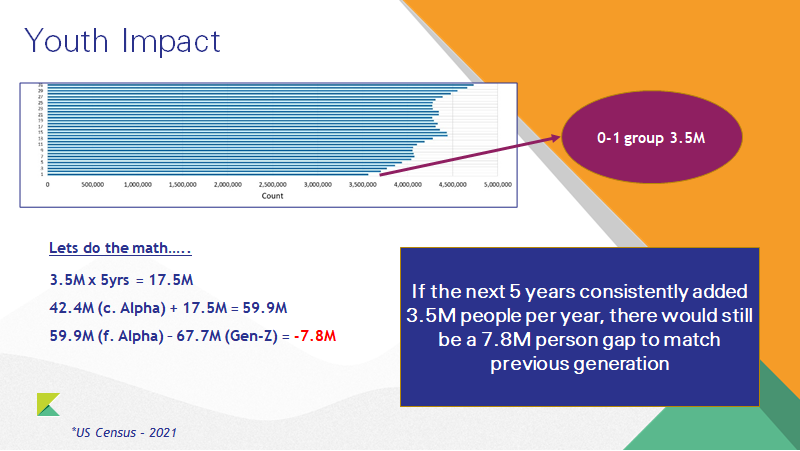
Workforce impact
Looking at the workforce, the presenters estimated a 2M deficit in the labor force in the next 8-16 years.
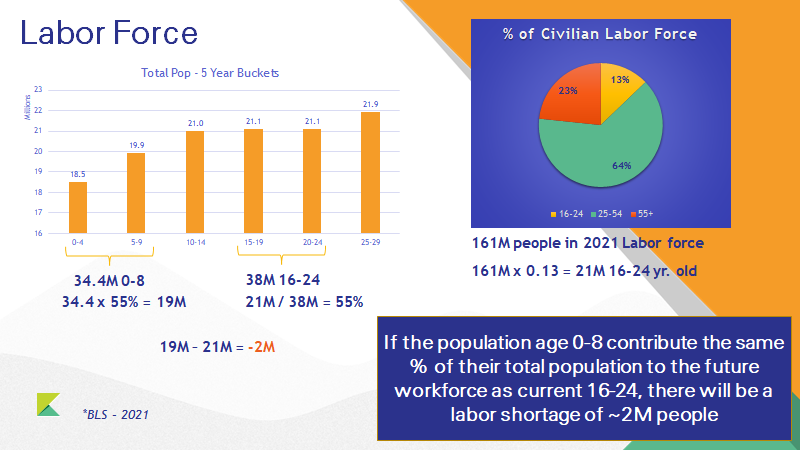
This reduction in the workforce could have profound economic and societal impacts. The reduction could exacerbate the burden on the working-age population to support an increasingly aged society, straining social security and healthcare systems. It could also lead to labor shortages in critical sectors, driving up wages, and potentially causing inflation. With a smaller labor force, economic growth could stagnate or even decline, impacting living standards. Furthermore, the reduction could impede innovation and technological progress, as these are often driven by young, dynamic participants in the workforce. Lastly, this demographic shift could lead to significant changes in policies, including those related to immigration, retirement age, and work-life balance, as countries strive to mitigate the effects of a shrinking workforce.
Mitigating the effects
Many countries are proactively trying to tackle these issues. The Italian and Chinese governments, for example, have introduced a number of policies aimed at making it easier for families to have children, such as tax breaks and subsidies for childcare. The governments are also working to improve the quality of life for women, in the hope that this will encourage them to have more children.
In addition to these measures, the Chinese government is also investing heavily in automation and artificial intelligence. This is in an effort to reduce the country’s reliance on human labor and to make up for the shortfall in the workforce.
Immigration can serve as a viable solution to the economic challenges associated with declining birth rates. By supplementing the domestic labor force, immigrants can help maintain productivity levels and sustain economic growth in countries with a falling population. They bring with them a diversity of skills and talents, often filling labor gaps in various sectors. Moreover, a younger immigrant workforce can help balance the dependency ratio by supporting aging populations, thereby relieving some pressure off social security and healthcare systems. However, while immigration may benefit the receiving countries, it could also create challenges for the countries of origin. This phenomenon, often referred to as “brain drain,” can lead to a scarcity of skilled labor in these countries, hampering their development. Furthermore, it can exacerbate demographic imbalances if younger, working-age individuals are the ones predominantly leaving, thereby accelerating population aging in those countries. It’s therefore crucial for immigration policies to be considerate of both the source and destination countries’ needs to ensure sustainable global development.
It is too early to forecast the full impact of the measures being adopted by governments around the world, but our hope is that their policies can catch up to the current state of the world and even get ahead of what is coming.